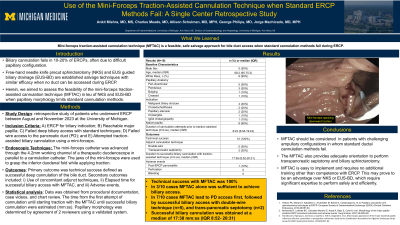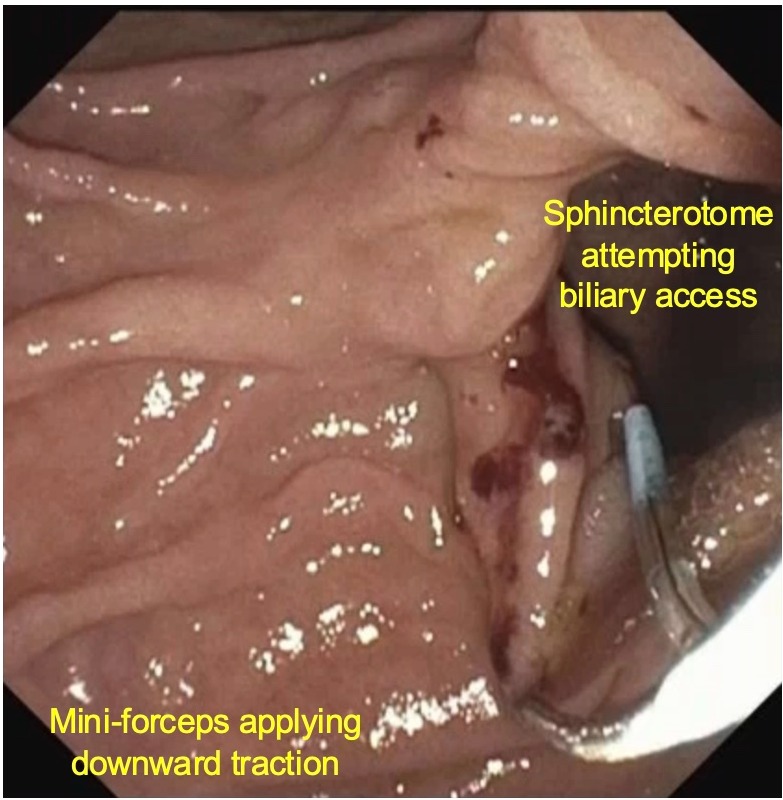Tuesday Poster Session
Category: Interventional Endoscopy
P4460 - Use of the Mini-Forceps Traction-Assisted Technique for Difficult Biliary Cannulations in ERCP: A Single Center Retrospective Study
Tuesday, October 29, 2024
10:30 AM - 4:00 PM ET
Location: Exhibit Hall E

Has Audio

Ankit Mishra, MD
University of Michigan
Ann Arbor, MI
Presenting Author(s)
Ankit Mishra, MD1, Charles Meade, MD2, Jorge D. Machicado, MD2
1University of Michigan, Ann Arbor, MI; 2University of Michigan Health, Ann Arbor, MI
Introduction: When biliary access cannot be achieved, adjunct techniques that use pancreatic duct (PD) access are often employed. If no duct can be accessed with these basic maneuvers, free-hand needle knife precut sphincterotomy (NKS) or EUS-guided biliary drainage (EUS-BD) are well established options. We report the use of the mini-forceps traction-assisted technique (MFTT) for difficult biliary cannulations as an alternative to NKS or EU-BD.
Methods: We retrospectively reviewed cases where the MFTT was used to facilitate biliary access after basic cannulation techniques failed on accessing any duct. Mini-forceps (catheter diameter 3Fr; jaw outer diameter 1 mm; SpyBiteTM Max, Boston Scientific, MA, USA) were advanced through the channel of a therapeutic duodenoscope in parallel to a cannulation device and used to apply traction to the inferior duodenal fold while simultaneously attempting ductal access (Figure). We measured: A) Technical success; B) Use of concomitant adjunct cannulation techniques; C) Elapsed time to biliary access; and D) Adverse events (AEs). Data was obtained from procedural documentation, case videos, and chart review. Papillary morphology was determined by agreement of 2 reviewers using a validated system.
Results: The MFTT was used in 10 patients (50% females; median age 68.2 years [IQR 65-75.3]) after failing duct access with basic ERCP maneuvers over a median of 8:23 mm:ss (IQR 6:04-19:43). Most patients had native papillary anatomy (n=9) and a benign indication (n=6). Half had a peri-diverticular papilla, including 3 with intra-diverticular location, while the rest had pendulous (n=3), bulging (n=1), or creased papillae (n=1). Biliary access using with the MFTT was successful in all cases. In 3/10 cases, the mini-forceps technique alone was sufficient to achieve biliary access. In 7/10 cases, mini-forceps assisted PD access was first achieved and concomitant double-wire technique (n=5) or transpancreatic septotomy (n=2) were required while still applying traction with the mini-forceps. Biliary access was obtained at a median of 17:38 mm:ss (IQR 8:52-20:31). AEs occurred in 1 patient (post-ERCP pancreatitis).
Discussion: In ERCPs where the papilla is identified and no duct access is achieved with basic maneuvers, MFTT can be an easy, effective and safe alternative to free-hand NKS and EUS-BD. This technique seems especially useful when a periampullary diverticulum or redundant periampullary tissue impedes duct access. Future prospective comparative studies are needed.

Disclosures:
Ankit Mishra, MD1, Charles Meade, MD2, Jorge D. Machicado, MD2. P4460 - Use of the Mini-Forceps Traction-Assisted Technique for Difficult Biliary Cannulations in ERCP: A Single Center Retrospective Study, ACG 2024 Annual Scientific Meeting Abstracts. Philadelphia, PA: American College of Gastroenterology.
1University of Michigan, Ann Arbor, MI; 2University of Michigan Health, Ann Arbor, MI
Introduction: When biliary access cannot be achieved, adjunct techniques that use pancreatic duct (PD) access are often employed. If no duct can be accessed with these basic maneuvers, free-hand needle knife precut sphincterotomy (NKS) or EUS-guided biliary drainage (EUS-BD) are well established options. We report the use of the mini-forceps traction-assisted technique (MFTT) for difficult biliary cannulations as an alternative to NKS or EU-BD.
Methods: We retrospectively reviewed cases where the MFTT was used to facilitate biliary access after basic cannulation techniques failed on accessing any duct. Mini-forceps (catheter diameter 3Fr; jaw outer diameter 1 mm; SpyBiteTM Max, Boston Scientific, MA, USA) were advanced through the channel of a therapeutic duodenoscope in parallel to a cannulation device and used to apply traction to the inferior duodenal fold while simultaneously attempting ductal access (Figure). We measured: A) Technical success; B) Use of concomitant adjunct cannulation techniques; C) Elapsed time to biliary access; and D) Adverse events (AEs). Data was obtained from procedural documentation, case videos, and chart review. Papillary morphology was determined by agreement of 2 reviewers using a validated system.
Results: The MFTT was used in 10 patients (50% females; median age 68.2 years [IQR 65-75.3]) after failing duct access with basic ERCP maneuvers over a median of 8:23 mm:ss (IQR 6:04-19:43). Most patients had native papillary anatomy (n=9) and a benign indication (n=6). Half had a peri-diverticular papilla, including 3 with intra-diverticular location, while the rest had pendulous (n=3), bulging (n=1), or creased papillae (n=1). Biliary access using with the MFTT was successful in all cases. In 3/10 cases, the mini-forceps technique alone was sufficient to achieve biliary access. In 7/10 cases, mini-forceps assisted PD access was first achieved and concomitant double-wire technique (n=5) or transpancreatic septotomy (n=2) were required while still applying traction with the mini-forceps. Biliary access was obtained at a median of 17:38 mm:ss (IQR 8:52-20:31). AEs occurred in 1 patient (post-ERCP pancreatitis).
Discussion: In ERCPs where the papilla is identified and no duct access is achieved with basic maneuvers, MFTT can be an easy, effective and safe alternative to free-hand NKS and EUS-BD. This technique seems especially useful when a periampullary diverticulum or redundant periampullary tissue impedes duct access. Future prospective comparative studies are needed.

Figure: Figure 1: Example of mini-forceps traction-assisted biliary cannulation technique in a patient with intradiverticular papilla
Disclosures:
Ankit Mishra indicated no relevant financial relationships.
Charles Meade indicated no relevant financial relationships.
Jorge Machicado indicated no relevant financial relationships.
Ankit Mishra, MD1, Charles Meade, MD2, Jorge D. Machicado, MD2. P4460 - Use of the Mini-Forceps Traction-Assisted Technique for Difficult Biliary Cannulations in ERCP: A Single Center Retrospective Study, ACG 2024 Annual Scientific Meeting Abstracts. Philadelphia, PA: American College of Gastroenterology.
